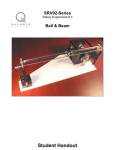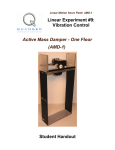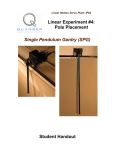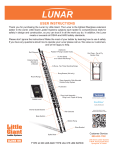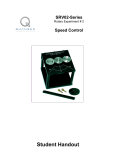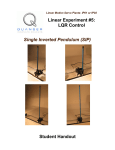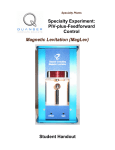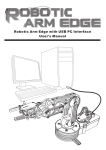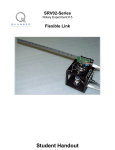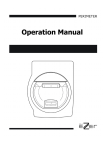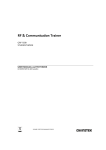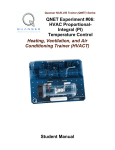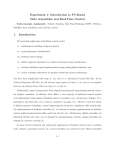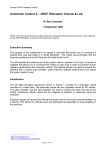Download IP01_2 LFJC_SIP_LQR_Student_610
Transcript
Linear Motion Servo Plants: IP01 or IP02 Linear Experiment #11: LQR Control Linear Flexible Joint Cart Plus Single Inverted Pendulum (LFJC+SIP) Student Handout LFJC-Plus-SIP Control Laboratory – Student Handout Table of Contents 1. Objectives............................................................................................................................1 2. Prerequisites.........................................................................................................................2 3. References............................................................................................................................2 4. Experimental Setup..............................................................................................................3 4.1. Main Components........................................................................................................3 4.2. Wiring..........................................................................................................................3 5. Controller Design Specifications.........................................................................................4 6. Pre-Lab Assignment: State-Space Representation..............................................................5 6.1. System Representation and Notations.........................................................................5 6.2. Assignment: System's Equations Of Motion And State-Space Representation...........6 7. In-Lab Procedure.................................................................................................................9 7.1. Experimental Setup......................................................................................................9 7.2. Design And Real-Time Implementation of a Linear Quadratic Regulator (LQR)......9 7.2.1. Objectives.............................................................................................................9 7.2.2. Experimental Procedure.......................................................................................9 Appendix A. Nomenclature...................................................................................................17 Document Number: 610 Revision: 01 Page: i LFJC-Plus-SIP Control Laboratory – Student Handout 1. Objectives The objective of the Linear Flexible Joint Cart Plus Single Inverted Pendulum (LFJC+SIP) experiment is to design a control system to balance a single inverted pendulum on a springdriven linear cart while minimizing the spring deflection (i.e., oscillation). This should only be achieved by controlling the input (i.e. motorized) cart position. The experiment consists of a system of two carts sliding on an IP01 or IP02 track, as shown in Figure 1. While one of the two carts is motorized and drives the system (e.g. IP01 or IP02), the second cart, a LFJC-PEN-E, is passive and coupled to the first one through a linear spring. The shafts of these elements are coupled to a rack and pinion mechanism in order to input the driving force to the system and to measure the two cart positions. An single pendulum rod is mounted atop the LFJC-PEN-E output cart and is free to fall along the LFJC's axis of motion. The single rod has its axis of rotation perpendicular to the direction of motion of the LFJ cart. Figure 1 LFJC-PEN-E-Plus-SIP Coupled to an IP02 During the course of this experiment, you will become familiar with the design and implementation of a full-state Linear Quadratic Regulator (LQR). At the end of the session, you should know the following: How to mathematically model the Linear Flexible Joint Cart Plus Single Inverted Pendulum (LFJC+SIP) coupled to an IP01 or IP02 linear servo plant, using, for example, Lagrangian mechanics or force analysis on free body diagrams. How to obtain a state-space representation of the open-loop system. How to design, simulate, and tune a LQR-based state-feedback controller satisfying Document Number: 610 Revision: 01 Page: 1 LFJC-Plus-SIP Control Laboratory – Student Handout the closed-loop system's desired design specifications. How to use integral action to eliminate steady-state error. How to implement your LQ Regulator in real-time and evaluate its actual performance. How to tune on-line and in real-time your LQR so that the actual linear-flexiblelinkage-cart system meets the closed-loop design requirements. 2. Prerequisites To successfully carry out this laboratory, the prerequisites are: i) To be familiar with your IP01 or IP02 main components (e.g. actuator, sensors), your data acquisition card (e.g., Q8/Q4/MultiQ), and your power amplifier (e.g. UPM), as described in References [2], [4], and [5]. ii) To be familiar with your Linear Flexible Joint Cart (LFJC-PEN-E) module, as described in Reference [3]. iii) To have successfully completed the pre-laboratory described in Reference [1]. Students are therefore expected to be familiar in using WinCon to control and monitor the plant in real-time and in designing their controller through Simulink. iv) To be familiar with the complete wiring of your IP01 or IP02 servo plant, as per dictated in Reference [2] and carried out in pre-laboratory [1]. v) To be familiar with the complete wiring of your LFJC-PEN-E module, as per dictated in Reference [3]. vi) To be familiar with LQR design theory and working principles. vii) To be familiar with FFT theory and working principles. 3. References [1] IP01 and IP02 – Linear Experiment #0: Integration with WinCon – Student Handout. [2] IP01 and IP02 User Manual. [3] IP01 and IP02 – Linear Flexible Joint Cart Plus Single Inverted Pendulum (LFJC+SIP) User Manual. [4] Q8 User Manual. [5] Universal Power Module User Manual. [6] WinCon User Manual. [7] IP01 and IP02 - Linear Experiment #1: PV Position Control – Student Handout. [8] LFJC-Plus-SIP Dynamic Equations - Maple Worksheet. Document Number: 610 Revision: 01 Page: 2 LFJC-Plus-SIP Control Laboratory – Student Handout 4. Experimental Setup 4.1. Main Components To setup this experiment, the following hardware and software are required: Power Module: Quanser UPM 1503 / 2405, or equivalent. Data Acquisition Board: Quanser Q8 / Q4 / MultiQ PCI / MQ3, or equivalent. Linear Motion Servo Plant: Quanser IP01 or IP02, as represented in Figure 1. LFJC-PEN-E: Quanser LFJC-PEN-E module, as seen in Figure 1. Real-Time Control Software: The WinCon-Simulink-RTX configuration, as detailed in Reference [6], or equivalent. For a complete and detailed description of the main components comprising this setup, please refer to the manuals corresponding to your configuration. 4.2. Wiring To wire up the system, please follow the default wiring procedures for your IP01 or IP02 as well as for the LFJC-PEN-E module, as fully described in References [2] and [3], respectively. When you are confident with your connections, you can power up the UPM. Document Number: 610 Revision: 01 Page: 3 LFJC-Plus-SIP Control Laboratory – Student Handout 5. Controller Design Specifications In the present laboratory (i.e. the pre-lab and in-lab sessions), you will design and implement a control strategy based on the Linear Quadratic Regulator (LQR) scheme. As a primary objective, the obtained optimal feedback gain vector, K, should allow you to keep the single inverted pendulum balanced as well as to track the spring-driven load cart to a desired position as quickly as possible while minimizing its overshoot, residual oscillation, and steady-state error. The corresponding control effort should also be looked at and minimized. Please refer to your in-class notes, as needed, regarding the LQR design theory and the corresponding implementation aspects of it. Generally speaking, the purpose of optimal control is to allow for best trade-off between performance and cost of control. Tune the LQR controlling the LFJC-Plus-SIP system in order to satisfy the following design performance requirements: 1. Regulate the pendulum angle around its upright position and never exceed a ± 2.5degree-deflection from it, i.e.: α ≤ 2.5 [ deg ] 2. While regulating both inverted pendulum and linear cart positions, minimize the spring deflection, xs, such that: xs ≤ 10.0 [ mm ] 3. Regulate the driving cart position, xc, so that it never exceeds the following: xc ≤ 40.0 [ mm ] 4. Have no saturation in the system. In other words, the commanded motor input voltage Vm (proportional to the control effort produced) should not make the power amplifier (e.g. UPM) go into saturation. As a remark, it can be seen that the previous design requirements bear on the system's three outputs: xc, xs, and α. Therefore our inverted-pendulum-linear-cart system consists of three outputs, for one input, Vm. Document Number: 610 Revision: 01 Page: 4 LFJC-Plus-SIP Control Laboratory – Student Handout 6. Pre-Lab Assignment: State-Space Representation 6.1. System Representation and Notations A schematic of the Linear Flexible Joint Cart Plus Single Inverted Pendulum (LFJC+SIP) mounted on an IP01 or IP02 linear-cart-and track system is represented in Figure 2. The LFJC-plus-SIP-plus-IP01-or-IP02 system's nomenclature is provided in Appendix A. Figure 2 Schematic of the LFJC-Plus-SIP System As illustrated in Figure 2, the positive direction of linear displacement is to the right when facing the cart. Furthermore, the positive sense of rotation is defined to be counterclockwise (CCW), when facing the linear cart. Also, the zero angle, modulus 2π, (i.e. α = 0 rad [2π]) corresponds to the inverted pendulum perfectly vertical and pointing upward. Document Number: 610 Revision: 01 Page: 5 LFJC-Plus-SIP Control Laboratory – Student Handout The variation in the linear spring length, xs, is defined below: x s( t ) = x 2( t ) − x c( t ) This equation shows that an extension of the linear spring corresponds to xs > 0, while a spring compression is equivalent to xs < 0. 6.2. Assignment: System's Equations Of Motion And State-Space Representation The determination of the LFJC-plus-SIP-plus-IP01-or-IP02 system's equations of motion is derived in Reference [8] as well as in the file titled LFJC+SIP IP01_2 Equations.html. The energy-based Lagrange's method is used to obtain the dynamic model of the system. In this approach, the single input to the system is considered to be Fc, and the three Lagrangian coordinates (a.k.a. generalized coordinates) are chosen to be: xc, xs, and α. It is reminded that the reference frame used is defined in Figure 2. Since the input U is set in a first time to be Fc, the driving force of the linear motorized cart (e.g. IP01 or IP02), we have: U = Fc [1] The system's state vector, X, is chosen to include the generalized coordinates and their firstorder time derivatives as well as an integrator on the cart's position to eliminate steady-state error. Therefore, X is defined such that its transpose is as follows: d d d xc( t ) d t ⎤⎥⎥ X T = ⎡⎢⎢ xc( t ), xs( t ), α ( t ), x c( t ), xs( t ), α ( t ), ⌠ ⎮ [2] ⎮ d t d t d t ⌡ ⎣ ⎦ Using the small angle approximation to linearize the system's three equations of motion, the state-space representation of that system can be derived to verify the following relationship: ∂ X=AX+BU [3] ∂t The state transition matrix, A, results to be as follows: Document Number: 610 Revision: 01 Page: 6 LFJC-Plus-SIP Control Laboratory – Student Handout ⎡0 ⎢ ⎢0 ⎢ ⎢ ⎢0 ⎢ ⎢ ⎢ ⎢ ⎢0 ⎢ ⎢ A = ⎢⎢ ⎢ ⎢0 ⎢ ⎢ ⎢ ⎢ ⎢ ⎢0 ⎢ ⎢ ⎢ ⎢ ⎢⎢ ⎣1 0 0 1 0 0 0 0 0 1 0 0 0 0 0 1 0 0 Ks − Ks Mc − − − 0 Mc Ks Mp g B eq M c2 M c2 Mc Ks g ( M c2 + M p ) l p M c2 l p M c2 0 0 − B eq Mc − B eq2 M c2 B eq2 l p M c2 0 − − B eq2 − M c2 B eq2 l p M c2 − Bp l p M c2 B p ( M c2 + M p ) 0 Also the input matrix, B, is found to be with the following transpose: 1 1 ⎡ − 0 0 ⎤⎥ 0 0 B T = ⎢⎢ 0 ⎥ Mc Mc ⎣ ⎦ 2 M p l p M c2 0 0⎤ ⎥ 0⎥⎥ ⎥ 0⎥⎥ ⎥ ⎥ ⎥ 0⎥ ⎥ ⎥ ⎥ ⎥ ⎥ 0⎥⎥ ⎥ ⎥ ⎥ ⎥ 0⎥⎥ ⎥ ⎥ ⎥ ⎥ 0⎥⎦ [4] [5] Answer the following questions: 1. From the system's state-space representation, evaluate the matrices A and B for the case where the system's input U is equal to the IP01 or IP02 cart's DC motor voltage Vm, instead of the linear force Fc. The system's input U can now be expressed by: U = Vm [6] Hint #1: In order to convert the previously given force equation state-space representation to voltage input, it is reminded that the driving force, Fc, generated by the DC motor and acting on the cart through the motor pinion has already been determined in previous laboratories. As shown for example in Equation [B.9] of Reference [7], Fc can be expressed by: 2 d ηg Kg ηm Kt Km ⎛⎜⎜ xc( t ) ⎞⎟⎟ η K η K V ⎝ dt ⎠+ g g m t m [7] Fc = − 2 Rm r mp Rm r mp Hint #2: Evaluate matrices A and B by using the model parameter values given in References [2] and [3]. Ask your laboratory instructor what system configuration you are going to use in your in-lab session. In case no additional information is provided, assume that your Document Number: 610 Revision: 01 Page: 7 LFJC-Plus-SIP Control Laboratory – Student Handout system is composed of a LFJC-PEN-E module, together with its two additional masses, mounted against an IP02 cart, atop of which its additional weight is also attached. The long (i.e., 24-inch) single pendulum rod is also assumed. 2. Calculate the open-loop poles of the system. Is it stable? What is the type of the system? What can you infer regarding the system's dynamic behaviour? Do you see the need for a closed-loop controller? Explain. Hint: The characteristic equation of the open-loop system can be expressed by the equation shown below: det( s I − A ) = 0 [8] where det() is the determinant function, s is the Laplace operator, and I the identity matrix. Therefore, the system's open-loop poles can be seen as the eigenvalues of the state-space matrix A. Document Number: 610 Revision: 01 Page: 8 LFJC-Plus-SIP Control Laboratory – Student Handout 7. In-Lab Procedure 7.1. Experimental Setup Even if you don't configure the experimental setup entirely yourself, you should be at least completely familiar with it and understand it. If in doubt, refer to References [1], [2], [3], [4], [5], and/or [6]. The first task upon entering the lab is to ensure that the complete system is wired as fully described in References [2] and [3]. You should have become familiar with the complete wiring and connections of your IP01 or IP02 system during the preparatory session described in Reference [1]. If you are still unsure of the wiring, please ask for assistance from the Teaching Assistant assigned to the lab. When you are confident with your connections, you can power up the UPM. You are now ready to begin the lab. 7.2. Design And Real-Time Implementation of a Linear Quadratic Regulator (LQR) 7.2.1. Objectives To use the obtained LFJC-plus-SIP-plus-IP01-or-IP02 state-space representation to design the following kind of state-feedback controller: Linear Quadratic Regulator (LQR). To implement with WinCon a real-time LQR for your actual LFJC-plus-SIP-plusIP01-or-IP02 plant. To tune and implement the LQ Regulator on the actual system and in real-time with WinCon. To assess from the actual system response whether the closed-loop design requirements are satisfied. 7.2.2. Experimental Procedure Please follow the steps described below. Step1. If you have not done so yet, you can start-up MATLAB now. Depending on your system configuration, open the Simulink model file of type q_lqr_lfjce_sip_YY_ZZ.mdl, where YY for either 'ip01' or 'ip02', and ZZ for either for 'q8', 'q4', 'mq3', 'mqp', or 'nie'. Ask the TA assigned to this lab if you are unsure Document Number: 610 Revision: 01 Page: 9 LFJC-Plus-SIP Control Laboratory – Student Handout which Simulink model is to be used in the lab. You should obtain a diagram similar to the one shown in Figure 3. Figure 3 Actual Implementation of the LQR Closed-Loop System For The LFJC-plus-SIP-plus-IP02 The diagram directly interfaces with your hardware and runs the actual LFJC-plusSIP system connected to your IP01 or IP02 linear servo plant. To familiarize yourself with the diagram, it is suggested that you open both subsystems to get a better idea of their composing blocks as well as take note of the I/O connections. Of interest, it should be noticed that the subsystem interfacing to the IP01 cart implements a Bias Removal block in order to set both initial potentiometer voltages to zero upon starting the real-time controller. Also, check that your model sampling time should be set to 1 ms, i.e. Ts = 10-3 s. Step2. Before beginning the actual LQR implementation, you must run the MATLAB script called setup_lab_ip01_2_lfjc_sip.m. However, ensure beforehand that the CONTROLLER_TYPE flag is set to 'MANUAL'. This mode initializes, before starting on-line the tuning procedure, the optimal gain vector K to zero, i.e. [0,0,0,0,0,0,0]. The script also initializes all the LFJC, SIP, and IP01 or IP02 model parameters and user-defined configuration variables needed and used by the Simulink diagram. Lastly, it also calculates the state-space matrices, A and B, corresponding to the LFJC-plus-SIP-plus-IP01-or-IP02 system configuration that you defined. Check that the A and B matrices thus set in the MATLAB workspace correspond to the ones that you evaluated in your pre-lab assignment. Step3. The LQR feedback gain vector K now needs to be determined so that the desired design specifications, as previously defined, are met. Since it is used by the actual controller implemented in the Simulink model file, the 7-element vector variable K Document Number: 610 Revision: 01 Page: 10 LFJC-Plus-SIP Control Laboratory – Student Handout must also be set in the MATLAB workspace. Using the MATLAB 'lqr' function, calculate the optimal gain vector K corresponding to the two following weighting matrices Q and R: 0 0 0 0 0 0⎤ ⎡⎢ 4000 ⎥ ⎢⎢ 0 500 0 0 0 0 0 ⎥⎥ ⎥ ⎢ ⎢⎢ 0 0 3000 0 0 0 0 ⎥⎥ R = [1.0 ] 0 0 0 0 0 0 0 ⎥⎥ Q = ⎢⎢ [9] ⎥ ⎢⎢ ⎥ 0 0 0 0 0 0 0⎥ ⎢⎢ ⎥ ⎢ 0 0 0 0 0 0 0 ⎥⎥ ⎢⎢ ⎥ ⎢ 0 0 0 0 0 0 100 ⎥⎦ ⎣ CAUTION: Once K has been calculated, have your lab assistant check your controller gain values. DO NOT proceed to the next step without his or her approval. Step4. Calculate the location of the corresponding closed-loop poles. Compare them to the location of the open-loop poles found in your pre-lab assignment. Hint #1: You can use the MATLAB function 'eig' to determine the eigenvalues of the closedloop state-space matrix. Hint #2: The closed-loop state-space matrix can be expressed as: A-B*K. Step5. You are now ready to build the real-time code corresponding to your diagram, by using the WinCon | Build option from the Simulink menu bar. After successful compilation and download to the WinCon Client, you should be able to use WinCon Server to run in real-time your actual system. However, before doing so, manually move your LFJC-plus-IP01-or-IP02 cart system to the middle of the track (i.e., around the mid-stroke position) and make sure that it is free to move on both sides. Additionally, ensure that the pendulum is free to rotate over its full rotational range (±360º) from anywhere within the LFJ cart's full linear range of motion. Before starting the real-time controller, also follow the starting procedure for the inverted pendulum, as described in the following Step. Step6. Inverted Pendulum Starting Procedure. One important consideration to bear in mind for the pendulum starting procedure is that encoders take their initial position reading as zero when the real-time code is started. In our linearized model, it is reminded that the zero pendulum angle corresponds to a perfectly upright position. The starting procedure described hereafter finds the exact vertical position from the pendulum hanging straight down, at rest, in front of the LFJC linear cart. Document Number: 610 Revision: 01 Page: 11 LFJC-Plus-SIP Control Laboratory – Student Handout Step7. The starting procedure consists first of letting the pendulum come to perfect rest in the gantry configuration, so that it is hanging straight down. This is illustrated in Figure 4. Figure 4 LFJC-plus-SIP-plus-IP02 Starting Position Then, the real-time code can be started so that the exact ±π-radian angle is precisely known. To do this, click on the START/STOP button of the WinCon Server window. Finally, manually rotate the pendulum to its upright position. The LQR, initially turned off by the start-up logic implemented in the controller model file, should automatically kick in and become enabled once the pendulum is completely inverted (i.e., its angle reached zero). The controller becomes effective only once the vertical equilibrium point is reached. At this stage, you can let the inverted pendulum go without trying to help it any further. Your LQR real-time controller should now command the IP01 or IP02 cart position so that the system regulates a constant setpoint while maintaining the inverted pendulum balanced. This is depicted in Figure 5. Document Number: 610 Revision: 01 Page: 12 LFJC-Plus-SIP Control Laboratory – Student Handout Figure 5 LFJC-plus-SIP-plus-IP02 Balancing Position Step8. Open the three sinks xc (mm), xs (mm), and alpha (deg) in three separate WinCon Scopes. You should also check the system's control effort and saturation, as mentioned in the design specifications, by opening the V Command (V) scope located, for example, in the following subsystem path: LFJC-PEN-E + IP02: Actual Plant Q8/IP02 - Q8/. On the xc (mm) scope, you should now be able to monitor on-line, as the IP01 or IP02 motorized cart moves and drives the LFJC, the actual cart position regulating at its starting position. On the xs (mm) scope, you should be able to monitor on-the-fly, as both linear cart moves, the actual resulting spring elongation (i.e., compression or extension). On the alpha (deg) scope, you should be able to monitor in real-time the actual inverted pendulum angle as it fluctuates about the vertical axis at any given time. Hint #1: To open a WinCon Scope, click on the Scope button of the WinCon Server window and choose the display that you want to open (e.g., xc (mm)) from the selection list. Hint #2: For a better signal visualization, you can set the WinCon scope buffer to 20 seconds. To do so, use the Update | Buffer... menu item from the desired WinCon scope. Step9. What are your observations at this point? Does your actual LQR closed-loop implementation meet the desired design specifications? Step10. If it does not, then you should re-iterate the controller design by finely tuning the LQR weighting matrices, Q and R, and re-computing K so that the final system satisfies the design requirements. Iterate your manual LQR tuning as many times as Document Number: 610 Revision: 01 Page: 13 LFJC-Plus-SIP Control Laboratory – Student Handout necessary so that your actual system's performance meets the desired design specifications. Also remember to avoid system saturation by monitoring the corresponding control effort spent, by means of the V Command (V) scope. If you are still unable to achieve the required performance level, ask your T.A. for advice. Step11. Once your results are in agreement with the closed-loop requirements, they should look similar to those displayed in Figures 6, 7, 8, and 9, below. Also ensure that the actual commanded motor input voltage Vm (which is proportional to the actual control effort produced) does not go into saturation, as listed as part of the requirements. As an example, an acceptable command voltage Vm is illustrated in Figure 9. More specifically, it can be observed in Figure 9 that no saturation occurs in the system and that the commanded motor input voltage is always such that: V m ≤ 4.0 [ V ] Step12. Include the corresponding plots (e.g., screen captures of WinCon Scopes) in your lab report to support your observations. You should at least include the WinCon plots, that you obtained, equivalent to Figures 6, 7, 8, and 9. Also include your final Q and R matrices as well as the resulting LQR gain vector K. Ensure to properly document all your results and observations before leaving the laboratory session. Step13. Remember that there is no such thing as a perfect model. Specifically discuss in your lab report how your actual linear cart positions and inverted pendulum angle compare to their respective theoretical values? Outline the most prominent differences between the theoretical and actual responses. Is there any discrepancy in the results? If so, find some of the possible reasons. Document Number: 610 Revision: 01 Page: 14 LFJC-Plus-SIP Control Laboratory – Student Handout Figure 6 Actual Motorized Cart (IP02) Response: xc (mm) Scope Figure 7 Actual Spring Elongation Response: xs (mm) Scope Document Number: 610 Revision: 01 Page: 15 LFJC-Plus-SIP Control Laboratory – Student Handout Figure 8 Actual Inverted Pendulum Angle Response: alpha (deg) Scope Figure 9 Actual Command Voltage: V Command (V) Scope Document Number: 610 Revision: 01 Page: 16 LFJC-Plus-SIP Control Laboratory – Student Handout Appendix A. Nomenclature Table A.1, below, provides a complete listing of the symbols and notations used in the IP01 and IP02 mathematical modelling, as presented in this laboratory. The numerical values of the system parameters can be found in Reference [2]. Symbol Description MATLAB Notation Vm Motor Armature Voltage Vm Im Motor Armature Current Im Rm Motor Armature Resistance Rm Kt Motor Torque Constant Kt ηm Motor Efficiency Km Back-ElectroMotive-Force (EMF) Constant Km Jm Rotor Moment of Inertia Jm Kg Planetary Gearbox Gear Ratio Kg ηg Planetary Gearbox Efficiency Eff_g Mc Lumped Mass of the IP01 or IP02 Cart System, including the Rotor Inertia rmp Motor Pinion Radius r_mp Beq Equivalent Viscous Damping Coefficient as seen at the Motor Pinion Beq Fc Cart Driving Force Produced by the Motor xc Motorized Cart Linear Position xc ∂ x ∂t c Motorized Cart Linear Velocity xc_dot Time Integration of the Motorized Cart Linear Position xc_int ⌠ xc d t ⎮ ⎮ ⌡ Eff_m Mc Table A.1 IP01 and IP02 Model Nomenclature Table A.2, below, provides a complete listing of the symbols and notations used in the mathematical modelling of the Linear Flexible Joint Cart Plus Single Inverted Pendulum (LFJC+SIP) system, as presented in this laboratory. The numerical values of the LFJC- Document Number: 610 Revision: 01 Page: 17 LFJC-Plus-SIP Control Laboratory – Student Handout PEN-E-plus-SIP system parameters can be found in Reference [3]. Symbol Description Mc2 Mass of the Load Cart System Ks Linear Spring Stiffness Constant Beq2 Equivalent Viscous Damping Coefficient as seen at the Load Cart Position Pinion MATLAB Notation Mc2 Ks Beq2 x2 Load Cart Linear Position x2 ∂ x ∂t 2 Load Cart Linear Velocity x2_dot xs Linear Spring Elongation xs ∂ x ∂t s α Linear Spring Elongation Velocity xs_dot Pendulum Angle From the Upright Position alpha ∂ α ∂t Pendulum Angular Velocity Mp Pendulum Mass (with T-fitting) Mp Bp Pendulum Viscous Damping Coefficient as seen at the Pendulum Axis Bp Lp Pendulum Full Length (from Pivot to Tip) Lp lp Pendulum Length from Pivot to Center Of Gravity lp xp x-coordinate of the Pendulum Centre Of Gravity yp y-coordinate of the Pendulum Centre Of Gravity alpha_dot Table A.2 LFJC-Plus-SIP System Model Nomenclature Table A.3, below, provides a complete listing of the symbols and notations used in the LQR controller design, as presented in this laboratory. Document Number: 610 Revision: 01 Page: 18 LFJC-Plus-SIP Control Laboratory – Student Handout Symbol Description A, B, C, D State-Space Matrices of the LFJC-plus-SIP-plus-IP01or-IP02 System MATLAB Notation A, B, C, D X State Vector X Y System Output Vector Y K Optimal Feedback Gain Vector K U Control Signal (a.k.a. System Input) Q Non-Negative Definite Hermitian Matrix Q R Positive-Definite Hermitian Matrix R t Continuous Time dx Variation in the Linear Spring Length dx Table A.3 LQR Controller Nomenclature Document Number: 610 Revision: 01 Page: 19






















